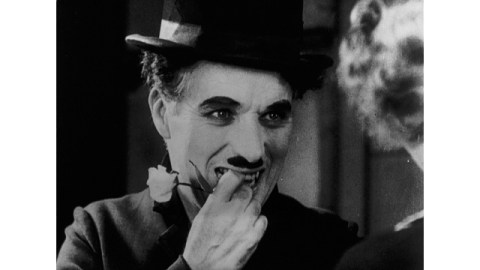How Chaplin’s Tramp Tramps on a Century Later

Baggy pants. A cane. A bowler hat. A mustache. These are the unlikely visual ingredients of one of the most important fictional characters of the last century around the world. A century ago, way back in 1914, Charles Chaplin’s “Little Tramp” made his first appearance on motion picture screens. Although more recent generations don’t remember the Tramp at all (or only by a series of 1980s IBM commercials featuring an impersonator), Chaplin’s character set the stage for so many other characterizations in media today that it’s almost like he’s peeking from around the virtual corner. Thanks to this centennial, Chaplin’s Little Tramp might finally come out into the spotlight once more and remind us of the romantic, poetic humanity that made him so popular in his time and allowed his legacy to tramp on today.
The first time Chaplin worked his Tramp character was for the film Mabel’s Strange Predicament, starring wide-eyed and long-tressed comedic actress Mabel Normand. But the first time the public saw the Tramp was in the second film shot, Kid Auto Races at Venice. Kid Auto Races at Venice premiered on February 7, 1914, with Mabel’s Strange Predicament opening two days later. Richard Attenborough 1992 bio-pic Chaplin, starring Robert Downey, Jr., depicts the birth of the Tramp in one scene where Charlie picks out the look of the character from a crowded wardrobe room and then bursts onto the scene of a hotel lobby where newlyweds are having their photo taken. (You can see the whole scene here.) The bowler hat, cane, etc., literally glow with the power of fate among the clutter. After the Tramp disrupts the proceedings and initiates a madcap chase, he wins the heart of the freshly minted bride and walks off with the girl. “My appearance got an enthusiastic response from everyone, including Mr. [Mack] Sennett [the director],” Chaplin recalled in 1933. “The clothes seemed to imbue me with the spirit of the character. He actually became a man with a soul—a point of view. I defined to Mr. Sennett the type of person he was. He wears an air of romantic hunger, forever seeking romance, but his feet won’t let him.” Attenborough and Downey follow Chaplin’s lead in showing the Tramp emerging fully formed from the start, but was that really the case?
If you watch Mabel’s Strange Predicament yourself (which you can do here), you’ll notice that the wedding photo scene doesn’t appear at all in the 11-minute one reeler. In fact, it’s hard to discern the Tramp’s “air of romantic hunger” between his public drunkenness (emphasized by a few tugs on a flask tucked into his vest), smoking, and frequent and unwelcome sexual advances on Mabel and other women in the film. Normand’s “predicament” consists of getting locked out of her hotel room clad only in her pajamas, which are as revealing as a prison jumpsuit, but were scandalous for the 1910s. The Tramp happens upon her in the hallway and begins his chase, which ends with a struggle with Mabel’s boyfriend, who actually ends up with the girl as their kiss closes the story. In Kid Auto Races at Venice (which you can watch here), the Tramp attends an actual soap box derby (with real racers and crowd) and interferes with the “filmmakers” trying to film the action. It’s essentially an extended photobombing of the documentary by the Tramp, who relentlessly preens before the camera as the filmmakers more and more aggressively toss him aside. Again, the “air of romantic hunger” feels awfully thin.
It’s hard to fault Chaplin for romanticizing the beginnings of the Tramp two decades later. Aside from his penchant for romanticizing everything, Chaplin realized that the Tramp the public knew from the later films written and directed by himself bore little resemblance to the Tramp of 1914 from the films written and directed by Sennett, the king of slapstick comedy who specialized in custard pie fights, pratfalls, Keystone Cops, and bathing beauties. (A short, but encyclopedic sample of Sennett’s work can be found here.) The world of vaudeville, where both Sennett and Chaplin came from, left little room for the romantic subtlety Chaplin later injected into his Tramp character. But the one thing in the Tramp that survives the death of vaudeville is the deep antiauthoritarian streak. The early Tramp crassly defies the filmmakers and hotel staff—the authorities on hand—in those early films, but Chaplin knew that the “little man” spirit itself, once refined, could become pure gold.
Once Chaplin could tinker with the Little Tramp in his own films by keeping the slapstick on the surface while developing who that person was on the inside, the Tramp, to use Chaplin’s words again, “actually became a man with a soul—a point of view.” That point of view remained antiauthoritarian, but not as a chaotic lord of misrule. Instead, the Tramp bends and, when necessary, breaks the rules to help downtrodden others, including himself. Whereas the early Tramp emphasizes the world-weariness (hence the drunkenness) of the down on his luck man who (we presume from his clothing) once travelled in better circles, the later Tramp wears his weariness and his tattered finery with a redeeming optimism—a holy fool who transforms the scene with undying hope. After a series of short films (including 1915’s The Tramp, the origin of the previously nameless character), Chaplin reeled off a series of feature-length masterpieces: The Kid (1921), The Gold Rush (1925), The Circus (1928), City Lights (1931), and Modern Times (1936), with the last two films eschewing the film industry’s shift to sound dialogue in the late 1920s.
The Tramp “retired” at the end of Modern Times, which was released on February 5, 1936, almost 22 years later to the day of his first appearance. The Tramp never spoke, but in Modern Timeshe sings. Caught on stage without the lyrics he’d scribbled onto his shirt cuffs, the Tramp improvises a nonsense song of Italian- and French-sounding gibberish while making himself perfectly clear through pantomime. Even when the Tramp finally uses his voice, he demonstrates that words are unnecessary. As fellow silent film star Lillian Gish often remarked, the silents were never silent—instrumental music conveyed a message as universal as the acting itself. In our world of increasingly fragmented, personalized media, it’s hard to imagine the world-wide appeal of Chaplin’s Tramp. Everyone went to the movies back then, and everyone knew Charlie, Charlot, or whatever name he was known by locally.
The Tramp walks off into the distance at the end of Modern Times, but not before transforming the despair of his companion (an orphan played by Paulette Goddard, who later became Chaplin’s real-life wife) with his infectious optimism and smile. A Jewish barber who looks exactly like the Tramp appears in 1940’s The Great Dictator, in which Chaplin plays both the barber and a dictator named Adenoid Hynkel, a broad parody of Adolf Hitler. Chaplin denied that the barber was the Tramp, but the barber’s closing speech (after the barber and the dictator accidentally swap places) calls for peace with exactly the passion you’d expect from the Tramp. Years later, in 1959, during the madness of mutually assured destruction of the Cold War, Chaplin lamented the loss of the Tramp. “I was wrong to kill him,” Chaplin said. “There was room for the Little Man in the atomic age.” No one more than Chaplin understood the irony of the Tramp and Hitler sharing the same mustache—two “little men” using their irresistible charisma, but, alas, to opposite ends. After World War II, atomic weapons made the world a scarier and smaller place while making the little man and woman almost disappear.
But the Tramp lives on. Children’s characters such as (early, pre-corporate) Mickey Mouse and Bugs Bunny share the same Tramp DNA through their speaking truth to power and fighting for the powerless. Finding more adult Tramp-esque characters poses a greater challenge, but you’ll find them if you look long enough. I’ve always felt that Robert Downey, Jr., emerged from playing Chaplin with a little Chaplin permanently in his veins. Downey took Iron Man, a previously minor character in the Marvel Comics universe, and gave him a soul, a point of view. Granted, Tony Stark’s futuristic armor bears little resemblance to the Tramp’s tatters, but both wear them with hope for a better world and as an ever-present reminder of their current condition. Downey’s Stark defies authority and helps those most in need, something the Tramp would have done given the proper technology. When Tony Stark turns to a young boy for help in Iron Man 3, I couldn’t help but remember the Tramp in The Kid bonding with a poor child and discovering a new side of himself. Certainly the Iron Man films owe some of their appeal to special effects, but to me the greatest and most compelling effect is when Downey himself is at his most Chaplin-esque—a Tramp in knight’s armor.
What do we risk losing if we lose the Tramp a century later? All you need to know can be seen in the final “recognition” scene of 1931’s City Lights, the Tramp’s second-to-last film. Speaking years later of this last scene, in which a formerly blind flower girl (played by Virginia Cherrill) realizes that the benefactor behind the surgery that restored her sight wasn’t a rich man but, instead, the Tramp before her, Chaplin explained, “I’m not acting… Almost apologetic, standing outside myself and looking… It’s a beautiful scene, beautiful, and because it isn’t over-acted.” Characteristically, words failed Chaplin in his explanation, but just looking at his expression (still from the film shown above), you can read the empathy on his face, the “standing outside” of self to help another. “You can see now?” the Tramp asks the woman. In this staggeringly and increasingly unempathetic age, we need to open our eyes to the final truth of the Tramp—all we have is one another, so share the joy, the laughs, the love, the tears, because it’s the sharing that makes us human. If we can all see through the eyes of the Tramp today, the world will be a better, and funnier, place.
[Image:Charles Chaplin as the Little Tramp in City Lights (1931) from the final “recognition” scene.]





